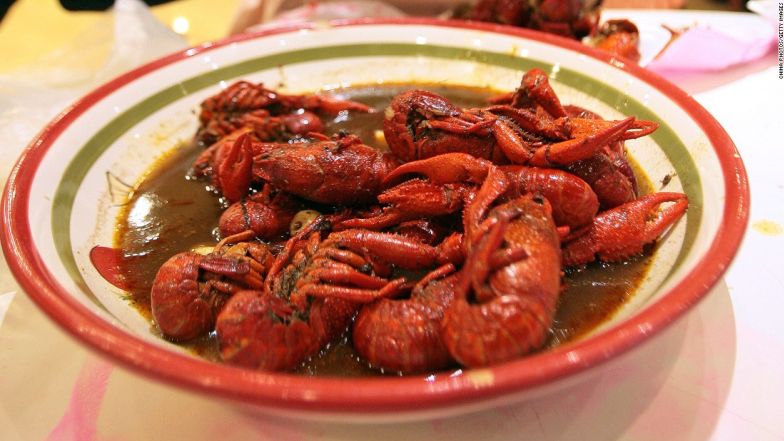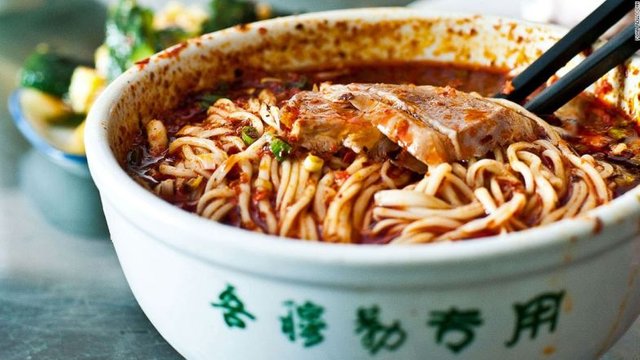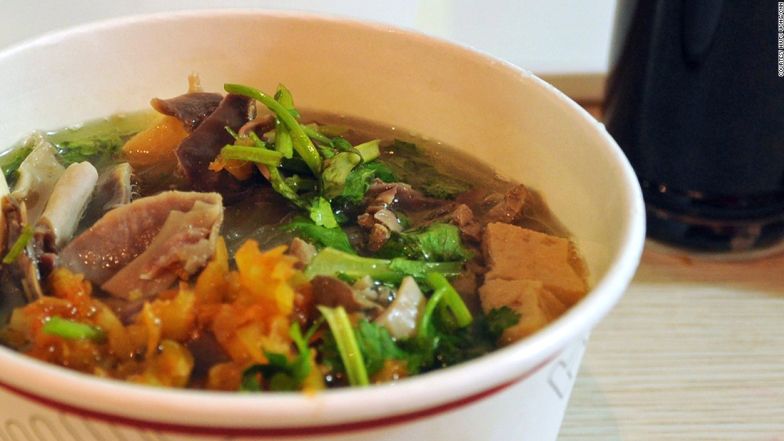The 14 Chinese dishes that make expats homesick
Proper street kebabs
The most unforgettable meals in China don't come from Michelin-starred restaurants.They're eaten in the streets in noisy, crowded, pungent food quarters in the heart of cities.
In places like Guijie in Beijing, Yunnan Nan Lu in Shanghai and Mingwalang in Nanjing, foodies can sample all sorts of freshly cooked skewers while witnessing the ultimate in food theater.
Islamic lamb kebabs with cumin, teppanyaki-style squid with five-spice sauce, gigantic "swords" of mind-blowing spicy chicken wings, grilled fresh oysters, fried pork tenderloin slices and razzle-dazzle exhibitions of vegetables-on-sticks.
Every bite of China's street kebabs is a combination of good food and a street-side buzz unique to the country.
10 things China does better than anywhere elseSpicy crayfish

Crayfish has taken China by a storm in the past decade or so.
Cities all over the country go gaga over the crustaceans, which are simmered in a broth with chili and abundant spices then served dry.
From spring to early autumn, crayfish-night-outs have become a ritual for many. Groups of friends find a jam-packed stall, sit on tiny plastic stools and order a bucket or two of bright red crayfish. No chopsticks needed -- digging in with the hands is preferred.
The preferred beverage to go with these tasty freshwater lobsters? Ice cold Chinese beer -- Reeb, Tsingtao, Yanjing, depending on the city.
- Lamb hot pot
Outside of China, spicy Sichuan hot pot and nourishing Cantonese hot pot are well known.
But in China, a country closely linked to Mongolian nomads, heavy and hearty lamb hot pot is hugely popular, especially in the north during the bitterly cold winter.
Likely originating during the Yuan Dynasty and made popular by Qing Dynasty emperors, lamb hot pot is dramatic to look at -- the copper container has a tall chimney in the middle to release steam from burning coal below, while the broth cooks in the outskirts of the pot.
Although a variety of meats, seafood and vegetables can be cooked, the star of the meal is plate after plate of wafer-thin lamb slices.
- Guilin rice noodles
Located in southern China among clear rivers and Karst Mountains, Guilin isn't only famous for its heavenly landscape, but bowls of refreshing rice noodles topped with preserved long beans, peanuts, bamboo shoots and spring onions.
There are noodles stalls everywhere in Guilin and surrounding areas. Locals like to mix the silky noodles and ingredients in a spicy and sour brine then eat them dry; or savor the whole combination in the beef stock.
Different meats can be added. The most popular tend to be slices of beef and chunks of beef belly.
- Yan Du Xian soup
Yan Du Xian is a nutritious soup known as the great comfort food of the Yangtze River Delta in early spring. It's a typical homey dish -- restaurants serve it, but the best always comes from a loving mom.
Seasonal delicacies, such as young bamboo shoots, chunks of pork belly, cured pork slices, firm tofu sheets and premium yellow rice wine, are put together in one clay pot for hours of simmering.
Xian is a taste unique to China and hard to find in Western food.
Similar to umami, it's subtler and often achieved by quickly cooking fresh seafood or slowly boiling meat and bones from poultry.
- Lanzhou hand-pulled noodles

The flagship halal dish from China, hand-pulled noodles hail from the wild, sandy lands of northwest China.
Each bowl is as much handicraft as hearty meal.
In what's usually a makeshift open kitchen, formidable Islamic noodle masters beat, fold and pull a flour-based dough, turning it into hair-thin noodles faster than most people can decide what to order.
A classic bowl of hand-pulled noodles comes with beef broth, slices of beef, coriander and spring onions.
Another popular derivation is knife-sliced noodles, or Dao Xiao Mian. To make this, the chef slashes chunks of dough in boiled water with eye-opening speed to make shorter, thicker and wider noodles.
- Sugar-coated haws (Candied haw/tong hu lu)
This is an iconic snack in northern China, especially in Beijing.
Sold by the stick, the dessert-to-go tastes great and looks greater -- bright red haws line up on a skewer in auspicious shapes, their sugary outer layers glimmering in the light.
Its nearest counterpart in the West might be toffee apples (known as candy apples in North America).
But haws are sourer than apples, so they offer a refreshing contrast to the sweet coating. Cold northern winters ensure the sugarcoating is firm and crispy.
- Stinky tofu
Fried, braised, streamed or grilled -- stinky tofu is delicious no matter how it's prepared.
Somewhat similar to cheese, it's an acquired taste or one that perhaps you have to grow up with to fully appreciate.
Stinky tofu is most popular in Hunan Province in central China, the Yangtze River Delta region (especially Shaoxing) and Taiwan.
Recipes vary from region to region, but the basic method is to let bean curd ferment in a special brine then deep-fry it. It can be eaten with chili sauce, soy sauce, sesame oil or kimchi.
Despite its underwhelming appearance and sharp smell, stinky tofu has a pleasant texture -- crispy on the outside, tender inside.
- Shanghai hairy crab
For Shanghainese, autumn isn't complete without a steamed, roe-laden hairy crab.
Every year the city hosts an influx of serious epicures from around the Sinoshpere who come to taste its legendary food signature.
Raised on crab farms in the Yangtze River estuary, the gray-shelled freshwater crab waves its big hairy claws in family kitchens, respectable restaurants and luxury hotels in September and October. Local mothers buy them from wet markets, steam them and eat them with gingery vinegar.
Specialty restaurants like Wang Bao He create expansive crab banquets out of the seasonal delicacy -- fried crab roe, crab roe tofu, steamed crab meatballs, crab meat dumplings and other inventive dishes might all be featured.
The traditional beverage to drink with a steamed hairy crab is warm yellow rice wine.
- Duck blood soup with vermicelli

Peking roast duck is only one of many outstanding duck dishes in China. For true fans of fowl, however, the city to be is actually Nanjing, capital of Jiangsu Province, and onetime capital of the Ming Dynasty as well as the Republic of China.
Nanjing residents love eating duck, from salted duck to pancakes made with duck grease to duck-blood soup, which has recently become popular in many parts of China.
In a bowl of duck-bone stock, duck blood is presented in beancurd-like cubes together with vermicelli, fried firm bean curd and bits of duck organs, such as liver and gizzard. It can be eaten any time of day with steamed buns, a bowl of rice or just on its own.
- Harbin red sausage
Harbin red sausage is a hugely popular cold cut in China.
People get it from delicatessens and eat it on its own as a snack, with bread as a picnic food or cook it with vegetables (especially cabbage).
Although traditional sausages in China are wind-dried and much sweeter than their Western counterparts, Harbin red sausages are smoked and have evolved from Lithuanian sausages.
The texture is more tender than salami, firmer than an American hotdog and drier than cooked British sausages. It's one of the wonderful Eurasian legacies of Harbin, capital of the Heilongjiang Province, which shares a border with Russia.
It was brought to China by Russian and Eastern European immigrates who came to construct trans-Siberian railways.
- Sugar-fried chestnuts
Street vendors in China use all sorts of curious appliances to make great foods.
For this ever-popular autumn snack, chefs fry chestnuts (which are cut open) in an enormous wok filled with black sand and granulated sugar. When properly done, they're soft, sweet and extremely fragrant.
Although chestnuts can be found all over the world, the best ones for this popular snack come from the regions around Beijing, especially the Fangshan area.
Bullfrog poached in chili oil (Sichuan boiled bullfrog)
Kermit might not like to hear this, but frogs are a delicacy in China, especially bullfrogs.
There are a variety of ways to cook bullfrogs in different parts of the country, but shui zhu -- a cooking technique from Sichuan cuisine -- has gained widespread popularity.
Pre-fried bullfrogs are poached in oil packed with strong spices, such as chili peppers and flower peppers, then served in a larger bowl and garnished with fresh coriander.
Often, the oil is still bubbling while being served. It's an unbeatable sharing dish for a big group. It's most satisfying with a bowl of white rice.Boiled chicken chops served cold (cold chopped chicken)
In China, chicken meat attached to the bones is considered the most flavorful.
That's why the majority of chicken dishes in China are served with the bones. This dish is typical.
Spring chickens are boiled till tender, then chopped up and served with a dipping sauce. The chunky meat is nice, but the tastiest bits are actually the bones, which locals love to suck. They're even yummier with the magic of the sweet, sour and gingery sauce.